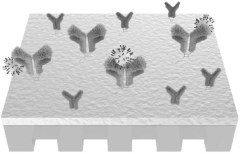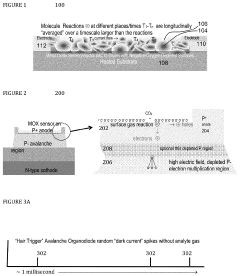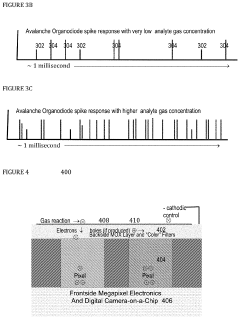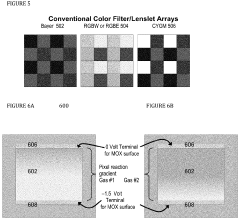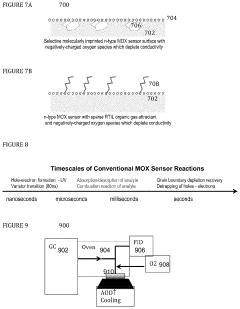Critical Analysis of Plasmonic Biosensor Role in Nanotechnology
SEP 29, 20259 MIN READ
Generate Your Research Report Instantly with AI Agent
Patsnap Eureka helps you evaluate technical feasibility & market potential.
Plasmonic Biosensor Evolution and Objectives
Plasmonic biosensors have emerged as a revolutionary technology at the intersection of photonics, nanotechnology, and biological sensing. The evolution of these sensors can be traced back to the early 1980s when the first surface plasmon resonance (SPR) biosensors were developed. This technological advancement was built upon the fundamental understanding of surface plasmon phenomena, which dates back to Wood's observations of anomalous diffraction patterns in 1902 and Otto and Kretschmann's configurations in the late 1960s.
The progression of plasmonic biosensor technology has been marked by several significant milestones. The commercialization of SPR instruments by Biacore in the early 1990s represented a pivotal moment, transforming laboratory concepts into practical analytical tools. Subsequently, the field witnessed a paradigm shift with the integration of nanomaterials, particularly gold and silver nanoparticles, enabling localized surface plasmon resonance (LSPR) sensing with enhanced sensitivity and miniaturization capabilities.
Recent technological trends have focused on overcoming traditional limitations through innovative approaches. The development of nanostructured plasmonic substrates has significantly improved detection limits, while advances in microfluidics integration have enhanced sample handling efficiency. The incorporation of machine learning algorithms for data analysis has further revolutionized signal processing capabilities, allowing for more accurate interpretation of complex biological interactions.
The primary objectives of current plasmonic biosensor research are multifaceted. First, there is a concerted effort to achieve unprecedented sensitivity levels, potentially reaching single-molecule detection capabilities. Second, researchers aim to develop multiplexed sensing platforms capable of simultaneously detecting multiple biomarkers, crucial for comprehensive disease diagnosis. Third, the miniaturization and integration of plasmonic biosensors into portable, user-friendly devices represents a key goal for point-of-care applications.
Looking forward, the field is moving toward smart biosensing systems that combine plasmonic technology with wireless connectivity and artificial intelligence. These integrated systems promise real-time monitoring capabilities with remote data transmission, particularly valuable for continuous health monitoring applications. Additionally, there is growing interest in developing sustainable plasmonic materials to replace conventional noble metals, addressing both cost and environmental concerns.
The convergence of plasmonic biosensors with other nanotechnologies, such as DNA nanotechnology and 2D materials, is opening new frontiers for sensor design. These hybrid approaches aim to overcome current limitations while expanding application possibilities across medical diagnostics, environmental monitoring, food safety, and biodefense sectors.
The progression of plasmonic biosensor technology has been marked by several significant milestones. The commercialization of SPR instruments by Biacore in the early 1990s represented a pivotal moment, transforming laboratory concepts into practical analytical tools. Subsequently, the field witnessed a paradigm shift with the integration of nanomaterials, particularly gold and silver nanoparticles, enabling localized surface plasmon resonance (LSPR) sensing with enhanced sensitivity and miniaturization capabilities.
Recent technological trends have focused on overcoming traditional limitations through innovative approaches. The development of nanostructured plasmonic substrates has significantly improved detection limits, while advances in microfluidics integration have enhanced sample handling efficiency. The incorporation of machine learning algorithms for data analysis has further revolutionized signal processing capabilities, allowing for more accurate interpretation of complex biological interactions.
The primary objectives of current plasmonic biosensor research are multifaceted. First, there is a concerted effort to achieve unprecedented sensitivity levels, potentially reaching single-molecule detection capabilities. Second, researchers aim to develop multiplexed sensing platforms capable of simultaneously detecting multiple biomarkers, crucial for comprehensive disease diagnosis. Third, the miniaturization and integration of plasmonic biosensors into portable, user-friendly devices represents a key goal for point-of-care applications.
Looking forward, the field is moving toward smart biosensing systems that combine plasmonic technology with wireless connectivity and artificial intelligence. These integrated systems promise real-time monitoring capabilities with remote data transmission, particularly valuable for continuous health monitoring applications. Additionally, there is growing interest in developing sustainable plasmonic materials to replace conventional noble metals, addressing both cost and environmental concerns.
The convergence of plasmonic biosensors with other nanotechnologies, such as DNA nanotechnology and 2D materials, is opening new frontiers for sensor design. These hybrid approaches aim to overcome current limitations while expanding application possibilities across medical diagnostics, environmental monitoring, food safety, and biodefense sectors.
Market Applications and Demand Analysis
The global market for plasmonic biosensors has witnessed substantial growth in recent years, driven primarily by increasing demand for rapid, sensitive, and portable diagnostic solutions across multiple sectors. The healthcare industry represents the largest market segment, with applications spanning from point-of-care diagnostics to pharmaceutical research and development. Current market estimates value the global biosensor market at approximately 25 billion USD, with plasmonic biosensors constituting a rapidly growing subsegment projected to expand at a compound annual growth rate of 9.8% through 2028.
Within the healthcare sector, the demand for plasmonic biosensors is particularly strong in infectious disease detection, where their ability to provide real-time, label-free detection of pathogens addresses critical needs in both developed and developing regions. The COVID-19 pandemic has significantly accelerated this trend, highlighting the importance of rapid diagnostic capabilities in managing public health crises and creating a sustained market pull for advanced biosensing technologies.
Environmental monitoring represents another significant market opportunity, with growing regulatory pressure driving demand for sensitive detection of pollutants, toxins, and pathogens in water and soil samples. The agricultural sector similarly shows increasing interest in plasmonic biosensors for detecting plant diseases, soil quality assessment, and food safety monitoring, with market adoption accelerating as costs decrease and field-deployable solutions become more robust.
The food and beverage industry constitutes a rapidly expanding application area, where plasmonic biosensors are increasingly utilized for quality control, allergen detection, and authentication of premium products. This segment is projected to grow at above-average rates as consumer demand for food safety and authenticity verification intensifies across global markets.
Geographically, North America and Europe currently dominate the plasmonic biosensor market, accounting for approximately 65% of global revenue. However, the Asia-Pacific region is emerging as the fastest-growing market, driven by substantial investments in healthcare infrastructure, increasing environmental concerns, and rapid industrialization in countries like China, India, and South Korea.
Key market challenges include the relatively high cost of plasmonic biosensor systems compared to conventional testing methods, technical complexity requiring specialized training, and the need for standardization across different platforms. Despite these challenges, the convergence of nanotechnology advancements, miniaturization trends, and increasing integration with digital health platforms is expected to significantly expand market penetration over the next decade, particularly as costs decrease through economies of scale and manufacturing innovations.
Within the healthcare sector, the demand for plasmonic biosensors is particularly strong in infectious disease detection, where their ability to provide real-time, label-free detection of pathogens addresses critical needs in both developed and developing regions. The COVID-19 pandemic has significantly accelerated this trend, highlighting the importance of rapid diagnostic capabilities in managing public health crises and creating a sustained market pull for advanced biosensing technologies.
Environmental monitoring represents another significant market opportunity, with growing regulatory pressure driving demand for sensitive detection of pollutants, toxins, and pathogens in water and soil samples. The agricultural sector similarly shows increasing interest in plasmonic biosensors for detecting plant diseases, soil quality assessment, and food safety monitoring, with market adoption accelerating as costs decrease and field-deployable solutions become more robust.
The food and beverage industry constitutes a rapidly expanding application area, where plasmonic biosensors are increasingly utilized for quality control, allergen detection, and authentication of premium products. This segment is projected to grow at above-average rates as consumer demand for food safety and authenticity verification intensifies across global markets.
Geographically, North America and Europe currently dominate the plasmonic biosensor market, accounting for approximately 65% of global revenue. However, the Asia-Pacific region is emerging as the fastest-growing market, driven by substantial investments in healthcare infrastructure, increasing environmental concerns, and rapid industrialization in countries like China, India, and South Korea.
Key market challenges include the relatively high cost of plasmonic biosensor systems compared to conventional testing methods, technical complexity requiring specialized training, and the need for standardization across different platforms. Despite these challenges, the convergence of nanotechnology advancements, miniaturization trends, and increasing integration with digital health platforms is expected to significantly expand market penetration over the next decade, particularly as costs decrease through economies of scale and manufacturing innovations.
Current Technological Landscape and Barriers
Plasmonic biosensors represent a significant advancement in nanotechnology, combining optical physics with biological detection mechanisms to create highly sensitive diagnostic tools. The current technological landscape shows remarkable progress in this field, with several key developments emerging in recent years. Surface plasmon resonance (SPR) and localized surface plasmon resonance (LSPR) technologies have become the dominant approaches, with commercial systems now available from companies like Biacore (now part of Cytiva), Reichert Technologies, and BioNavis.
Despite these advances, several critical barriers impede the widespread adoption and further development of plasmonic biosensors. The most significant challenge remains the complexity of fabrication processes for nanostructured plasmonic surfaces. Current methods often require expensive equipment such as electron beam lithography or focused ion beam milling, limiting scalability and increasing production costs. Additionally, the reproducibility of these nanostructures presents a substantial hurdle, as minor variations in geometry can significantly affect sensor performance.
Another major technical barrier is the limited specificity in complex biological samples. While plasmonic biosensors demonstrate excellent sensitivity in controlled environments, their performance often deteriorates in real-world applications involving complex matrices like blood, saliva, or environmental samples. Non-specific binding and matrix interference effects continue to challenge researchers developing practical applications.
Integration challenges also persist in the field. Combining plasmonic sensing elements with microfluidics, electronics, and data processing systems remains complex, particularly when developing point-of-care or field-deployable devices. The miniaturization of supporting optical components presents additional difficulties in creating truly portable systems.
From a geographical perspective, research and development in plasmonic biosensors show distinct patterns. North America and Europe lead in fundamental research and commercial development, with significant contributions from institutions like MIT, Imperial College London, and ETH Zurich. Meanwhile, Asian countries, particularly China, South Korea, and Singapore, have rapidly increased their research output and patent filings in the past decade, focusing on novel materials and manufacturing approaches.
The regulatory landscape adds another layer of complexity, especially for medical applications. The stringent requirements for clinical validation and approval processes create substantial barriers to market entry for new plasmonic biosensor technologies, extending development timelines and increasing costs. This regulatory burden disproportionately affects smaller companies and academic spin-offs attempting to commercialize innovative approaches.
Despite these advances, several critical barriers impede the widespread adoption and further development of plasmonic biosensors. The most significant challenge remains the complexity of fabrication processes for nanostructured plasmonic surfaces. Current methods often require expensive equipment such as electron beam lithography or focused ion beam milling, limiting scalability and increasing production costs. Additionally, the reproducibility of these nanostructures presents a substantial hurdle, as minor variations in geometry can significantly affect sensor performance.
Another major technical barrier is the limited specificity in complex biological samples. While plasmonic biosensors demonstrate excellent sensitivity in controlled environments, their performance often deteriorates in real-world applications involving complex matrices like blood, saliva, or environmental samples. Non-specific binding and matrix interference effects continue to challenge researchers developing practical applications.
Integration challenges also persist in the field. Combining plasmonic sensing elements with microfluidics, electronics, and data processing systems remains complex, particularly when developing point-of-care or field-deployable devices. The miniaturization of supporting optical components presents additional difficulties in creating truly portable systems.
From a geographical perspective, research and development in plasmonic biosensors show distinct patterns. North America and Europe lead in fundamental research and commercial development, with significant contributions from institutions like MIT, Imperial College London, and ETH Zurich. Meanwhile, Asian countries, particularly China, South Korea, and Singapore, have rapidly increased their research output and patent filings in the past decade, focusing on novel materials and manufacturing approaches.
The regulatory landscape adds another layer of complexity, especially for medical applications. The stringent requirements for clinical validation and approval processes create substantial barriers to market entry for new plasmonic biosensor technologies, extending development timelines and increasing costs. This regulatory burden disproportionately affects smaller companies and academic spin-offs attempting to commercialize innovative approaches.
Contemporary Plasmonic Sensing Methodologies
01 Plasmonic nanostructures for enhanced biosensing
Plasmonic biosensors utilize nanostructures such as nanoparticles, nanorods, and nanogratings to enhance detection sensitivity through localized surface plasmon resonance (LSPR). These nanostructures create strong electromagnetic field enhancements at their surfaces, allowing for the detection of biomolecular interactions at extremely low concentrations. The specific geometry and composition of these nanostructures can be tailored to optimize sensing performance for different bioanalytes.- Plasmonic nanostructures for biosensing: Plasmonic biosensors utilize nanostructures such as gold or silver nanoparticles that exhibit localized surface plasmon resonance (LSPR) for highly sensitive detection of biomolecules. These nanostructures can be engineered with specific shapes and sizes to enhance the sensing performance. When target analytes bind to the functionalized surface of these nanostructures, they cause measurable shifts in the resonance wavelength, enabling label-free detection with high sensitivity and specificity.
- Surface plasmon resonance (SPR) optical configurations: Various optical configurations are employed in plasmonic biosensors to excite and detect surface plasmon resonance. These include prism-based coupling (Kretschmann configuration), waveguide structures, and grating-coupled systems. Advanced optical designs incorporate microfluidic channels for sample delivery and specialized detection schemes such as phase-sensitive detection or imaging SPR to improve sensitivity and enable multiplexed sensing applications.
- Integration with microfluidic and lab-on-chip platforms: Plasmonic biosensors are increasingly integrated with microfluidic systems to create lab-on-chip platforms for point-of-care diagnostics. These integrated systems enable precise control of sample flow, reduced sample volumes, and automated processing. The combination of plasmonic sensing with microfluidics enhances detection capabilities while minimizing reagent consumption and analysis time, making these platforms suitable for rapid clinical diagnostics and environmental monitoring applications.
- Signal enhancement and processing techniques: Various techniques are employed to enhance the sensitivity of plasmonic biosensors, including signal amplification strategies and advanced data processing algorithms. These include the use of secondary nanoparticles for signal enhancement, plasmonic coupling effects, and machine learning approaches for signal analysis. Enhanced signal processing methods can filter noise, compensate for environmental variations, and extract meaningful data from complex biological samples, significantly improving detection limits and reliability.
- Novel plasmonic materials and hybrid structures: Research in plasmonic biosensors has expanded beyond traditional gold and silver materials to include novel plasmonic materials and hybrid structures. These include graphene-plasmonic hybrids, semiconductor-metal combinations, and metamaterials with engineered optical properties. Such advanced materials can offer improved sensitivity, broader spectral ranges, and enhanced durability compared to conventional plasmonic materials, enabling detection of a wider range of biomarkers with greater precision.
02 Integrated optical waveguide plasmonic biosensors
These biosensors combine plasmonic sensing elements with optical waveguide technology to create highly sensitive detection platforms. By integrating plasmonic structures with waveguides, the interaction length between light and the sensing medium is increased, resulting in improved sensitivity. These integrated systems enable miniaturization and can be incorporated into lab-on-a-chip devices for point-of-care diagnostics and real-time monitoring applications.Expand Specific Solutions03 Surface functionalization techniques for plasmonic biosensors
Various surface modification strategies are employed to functionalize plasmonic biosensors for specific target recognition. These include the attachment of antibodies, aptamers, or other biorecognition elements to the sensor surface. Surface chemistry techniques such as self-assembled monolayers, click chemistry, and biotin-streptavidin interactions are used to create stable and selective sensing interfaces that minimize non-specific binding while maximizing target capture efficiency.Expand Specific Solutions04 Signal processing and readout methods for plasmonic biosensors
Advanced signal processing techniques and readout methods are crucial for extracting meaningful data from plasmonic biosensors. These include spectroscopic analysis, phase detection, intensity measurements, and image processing algorithms. Machine learning approaches are increasingly being applied to analyze complex sensor responses and improve detection limits. Real-time data processing enables continuous monitoring applications in clinical diagnostics and environmental sensing.Expand Specific Solutions05 Novel applications of plasmonic biosensors
Plasmonic biosensors are being developed for diverse applications beyond traditional biomedical diagnostics. These include environmental monitoring, food safety testing, pharmaceutical quality control, and security applications. The high sensitivity and specificity of plasmonic sensing enable detection of various analytes including pathogens, toxins, biomarkers, and chemical contaminants. Emerging applications include wearable biosensors for continuous health monitoring and implantable devices for in vivo sensing.Expand Specific Solutions
Leading Research Institutions and Commercial Entities
Plasmonic biosensor technology in nanotechnology is currently in a growth phase, with the market expanding rapidly due to increasing applications in healthcare, environmental monitoring, and biodefense. The global market size is projected to reach significant value as demand for point-of-care diagnostics and real-time monitoring solutions grows. Technologically, the field shows varying maturity levels across different institutions. Leading academic players like Washington University in St. Louis, École Polytechnique Fédérale de Lausanne, and Northeastern University have demonstrated advanced research capabilities, while companies such as Onechip Bioelectronics and Xiamen Dilixin Technology are commercializing these innovations. Government research institutions like CSIC and KRISS provide critical standardization and validation support. The convergence of nanotechnology, photonics, and biotechnology is accelerating development, with recent breakthroughs in sensitivity and specificity showing promise for next-generation diagnostic applications.
École Polytechnique Fédérale de Lausanne
Technical Solution: EPFL has developed advanced plasmonic biosensors utilizing localized surface plasmon resonance (LSPR) technology with gold nanoparticles arranged in precise geometric patterns. Their proprietary nanofabrication techniques create highly sensitive detection platforms capable of single-molecule detection. The research team has pioneered a dual-mode sensing approach that combines LSPR with surface-enhanced Raman spectroscopy (SERS), significantly enhancing specificity while maintaining sensitivity. Their biosensors incorporate microfluidic integration for sample handling and have demonstrated detection limits in the femtomolar range for various biomarkers[1]. EPFL's plasmonic biosensors have been successfully applied to detect cancer biomarkers, pathogens, and environmental toxins with minimal sample preparation requirements.
Strengths: Exceptional sensitivity reaching single-molecule detection levels; dual-mode sensing capability enhances specificity; sophisticated nanofabrication expertise. Weaknesses: Complex fabrication processes may limit mass production capabilities; relatively high production costs compared to conventional biosensors; requires specialized equipment for operation and analysis.
Northeastern University
Technical Solution: Northeastern University has developed innovative plasmonic biosensors based on metamaterial architectures that exhibit extraordinary optical transmission properties. Their approach utilizes periodic nanohole arrays in metallic films that support surface plasmon polaritons with enhanced electromagnetic field confinement. The research team has pioneered a technique called "plasmonic nanofocusing" that concentrates electromagnetic energy into nanoscale volumes, dramatically improving detection sensitivity. Their biosensors incorporate stimuli-responsive hydrogel coatings that undergo conformational changes upon target binding, amplifying the plasmonic response[4]. Northeastern's platform features real-time monitoring capabilities with response times under 60 seconds and has demonstrated multiplex detection of up to 8 different biomarkers simultaneously. The technology has been successfully miniaturized into portable devices with integrated microfluidics and automated sample processing[5].
Strengths: Exceptional field enhancement through metamaterial design; rapid response time suitable for real-time monitoring; excellent multiplexing capabilities. Weaknesses: Complex optical setup requirements for some configurations; hydrogel coatings may degrade over time affecting long-term stability; limited shelf-life compared to some competing technologies.
Key Patents and Scientific Breakthroughs
A nanostructured plasmonic grating-inverted biosensor based on plasmonic
PatentPendingAU2023201970A1
Innovation
- A nanostructured planar grating-inverted biosensor with an inverted uniform grating, a metal plane sensing area, and specific layers that enhance plasmonic coupling, allowing for versatile detection of different biomarkers by optimizing the refractive indices and thicknesses of materials like sapphire, silicon, and metals, and improving the uniformity of sample interaction.
Sensors and sensing methods
PatentInactiveUS20230266291A1
Innovation
- The development of organodiode detectors and multisample sensors with nanoscale metal oxide surfaces that allow for direct, immediate, and real-time detection of individual gas reaction events, utilizing statistical processing and high-field gradients for enhanced sensitivity and rapid analyte capture, and the integration of plasmonic arrays for optical interaction with analytes.
Nanofabrication Techniques and Challenges
The fabrication of plasmonic biosensors represents one of the most challenging aspects in their development and implementation. Current nanofabrication techniques for plasmonic structures include electron beam lithography (EBL), focused ion beam (FIB) milling, nanoimprint lithography, and colloidal lithography. Each method offers distinct advantages and limitations that significantly impact sensor performance and commercial viability.
Electron beam lithography provides exceptional precision down to sub-10 nm resolution, making it ideal for creating highly uniform plasmonic nanostructures with precise geometrical parameters. However, EBL suffers from low throughput and high equipment costs, limiting its application in mass production scenarios. The serial nature of the writing process creates a fundamental bottleneck that remains unresolved despite technological advancements.
Focused ion beam milling offers direct writing capabilities for creating complex three-dimensional plasmonic structures without requiring masks. This technique enables rapid prototyping but introduces material damage through ion implantation and amorphization, potentially degrading the plasmonic properties of noble metals. Additionally, FIB shares the throughput limitations of EBL, restricting its use primarily to research environments.
Nanoimprint lithography has emerged as a promising approach for high-throughput fabrication, capable of replicating nanoscale features over large areas at significantly reduced costs. Nevertheless, challenges persist in master template fabrication, pattern transfer fidelity, and template durability over multiple imprinting cycles. The technique also struggles with creating high aspect ratio structures essential for certain plasmonic applications.
A critical challenge in plasmonic biosensor fabrication lies in achieving consistent surface chemistry for biomolecule immobilization while maintaining the integrity of the plasmonic structures. The functionalization process must provide uniform coverage without compromising the optical properties of the metallic nanostructures. Current approaches often result in heterogeneous surface coverage that impacts sensor reproducibility.
Material selection presents another significant challenge, with most plasmonic biosensors relying on gold and silver. While gold offers excellent biocompatibility and chemical stability, its plasmonic properties are inferior to silver, which suffers from rapid oxidation in biological environments. Alternative plasmonic materials such as aluminum and conductive oxides show promise but introduce new fabrication complexities related to deposition parameters and surface quality control.
The integration of plasmonic structures with microfluidic systems represents a persistent challenge, requiring precise alignment and compatible fabrication processes. Current solutions often involve complex multi-step procedures that reduce yield and increase production costs, hampering commercial adoption despite the clear advantages of integrated sensing platforms.
Electron beam lithography provides exceptional precision down to sub-10 nm resolution, making it ideal for creating highly uniform plasmonic nanostructures with precise geometrical parameters. However, EBL suffers from low throughput and high equipment costs, limiting its application in mass production scenarios. The serial nature of the writing process creates a fundamental bottleneck that remains unresolved despite technological advancements.
Focused ion beam milling offers direct writing capabilities for creating complex three-dimensional plasmonic structures without requiring masks. This technique enables rapid prototyping but introduces material damage through ion implantation and amorphization, potentially degrading the plasmonic properties of noble metals. Additionally, FIB shares the throughput limitations of EBL, restricting its use primarily to research environments.
Nanoimprint lithography has emerged as a promising approach for high-throughput fabrication, capable of replicating nanoscale features over large areas at significantly reduced costs. Nevertheless, challenges persist in master template fabrication, pattern transfer fidelity, and template durability over multiple imprinting cycles. The technique also struggles with creating high aspect ratio structures essential for certain plasmonic applications.
A critical challenge in plasmonic biosensor fabrication lies in achieving consistent surface chemistry for biomolecule immobilization while maintaining the integrity of the plasmonic structures. The functionalization process must provide uniform coverage without compromising the optical properties of the metallic nanostructures. Current approaches often result in heterogeneous surface coverage that impacts sensor reproducibility.
Material selection presents another significant challenge, with most plasmonic biosensors relying on gold and silver. While gold offers excellent biocompatibility and chemical stability, its plasmonic properties are inferior to silver, which suffers from rapid oxidation in biological environments. Alternative plasmonic materials such as aluminum and conductive oxides show promise but introduce new fabrication complexities related to deposition parameters and surface quality control.
The integration of plasmonic structures with microfluidic systems represents a persistent challenge, requiring precise alignment and compatible fabrication processes. Current solutions often involve complex multi-step procedures that reduce yield and increase production costs, hampering commercial adoption despite the clear advantages of integrated sensing platforms.
Regulatory Framework for Nanobiosensor Implementation
The regulatory landscape for nanobiosensor implementation presents a complex framework that varies significantly across global jurisdictions. In the United States, the Food and Drug Administration (FDA) has established specific guidelines for nanomaterial-based medical devices, requiring rigorous validation of plasmonic biosensors through pre-market approval processes. These regulations emphasize safety assessments, particularly regarding potential nanoparticle toxicity and long-term biocompatibility, which directly impacts the clinical translation of plasmonic biosensing technologies.
The European Union has implemented the more comprehensive REACH (Registration, Evaluation, Authorization and Restriction of Chemicals) regulation alongside the Medical Device Regulation (MDR), which together create stringent requirements for nanomaterial characterization and risk assessment. Manufacturers of plasmonic biosensors must provide detailed documentation on nanomaterial properties, potential environmental impacts, and disposal protocols, creating significant regulatory hurdles for market entry.
In Asia, regulatory approaches vary substantially, with Japan's Pharmaceuticals and Medical Devices Agency (PMDA) adopting science-based evaluation frameworks specifically for nanobiosensors, while China has recently strengthened its regulatory oversight through the National Medical Products Administration (NMPA) with particular focus on novel nanomaterials used in diagnostic applications.
International standardization efforts led by organizations such as ISO (International Organization for Standardization) have established technical committees dedicated to nanotechnology standardization (ISO/TC 229), which are developing crucial measurement protocols and reference materials for plasmonic biosensor validation. These standards are increasingly being incorporated into regulatory frameworks worldwide, facilitating global harmonization of approval processes.
Ethical considerations form another critical dimension of the regulatory landscape, particularly regarding data privacy when plasmonic biosensors are integrated into connected health systems. Regulations such as GDPR in Europe and HIPAA in the US impose strict requirements on data management practices for diagnostic technologies that generate patient information, adding another layer of compliance requirements for developers.
Looking forward, regulatory frameworks are evolving toward adaptive licensing approaches that acknowledge the rapid pace of nanotechnology innovation. Several jurisdictions are exploring regulatory sandboxes that allow controlled testing of novel plasmonic biosensor applications while gathering real-world evidence of safety and efficacy, potentially accelerating the path to market for transformative diagnostic technologies while maintaining appropriate safeguards.
The European Union has implemented the more comprehensive REACH (Registration, Evaluation, Authorization and Restriction of Chemicals) regulation alongside the Medical Device Regulation (MDR), which together create stringent requirements for nanomaterial characterization and risk assessment. Manufacturers of plasmonic biosensors must provide detailed documentation on nanomaterial properties, potential environmental impacts, and disposal protocols, creating significant regulatory hurdles for market entry.
In Asia, regulatory approaches vary substantially, with Japan's Pharmaceuticals and Medical Devices Agency (PMDA) adopting science-based evaluation frameworks specifically for nanobiosensors, while China has recently strengthened its regulatory oversight through the National Medical Products Administration (NMPA) with particular focus on novel nanomaterials used in diagnostic applications.
International standardization efforts led by organizations such as ISO (International Organization for Standardization) have established technical committees dedicated to nanotechnology standardization (ISO/TC 229), which are developing crucial measurement protocols and reference materials for plasmonic biosensor validation. These standards are increasingly being incorporated into regulatory frameworks worldwide, facilitating global harmonization of approval processes.
Ethical considerations form another critical dimension of the regulatory landscape, particularly regarding data privacy when plasmonic biosensors are integrated into connected health systems. Regulations such as GDPR in Europe and HIPAA in the US impose strict requirements on data management practices for diagnostic technologies that generate patient information, adding another layer of compliance requirements for developers.
Looking forward, regulatory frameworks are evolving toward adaptive licensing approaches that acknowledge the rapid pace of nanotechnology innovation. Several jurisdictions are exploring regulatory sandboxes that allow controlled testing of novel plasmonic biosensor applications while gathering real-world evidence of safety and efficacy, potentially accelerating the path to market for transformative diagnostic technologies while maintaining appropriate safeguards.
Unlock deeper insights with Patsnap Eureka Quick Research — get a full tech report to explore trends and direct your research. Try now!
Generate Your Research Report Instantly with AI Agent
Supercharge your innovation with Patsnap Eureka AI Agent Platform!

